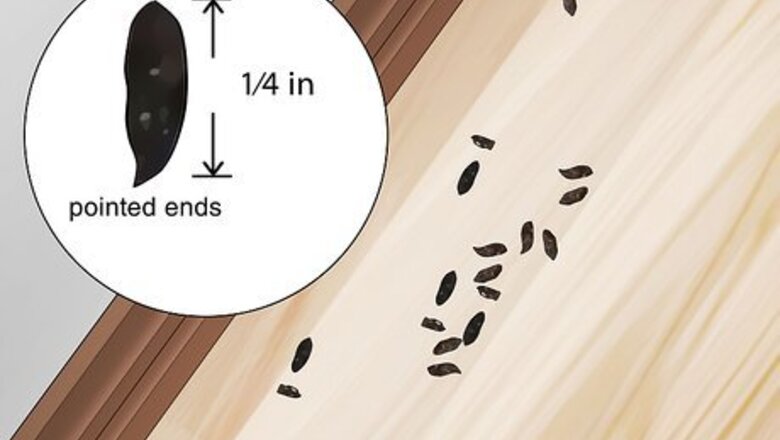
views
X
Research source
Fortunately, there are a few surefire methods you can use to draw the mice out and get rid of them once and for all.This article is based on an interview with our MMPC-certified pest control specialist, Kevin Carrillo. Check out the full interview here.
Traps

Look for mouse droppings to tell you’re dealing with mice. The best way to figure out what’s in your walls is to take a look inside dark, quiet areas, like pantries, cabinets, and closets. Try to find mouse droppings, or mouse poop, which are little oval pellets (and there’s usually a lot of them in one spot). Once you find those droppings, you’ll know you’re dealing with mice running around your walls. Mice droppings are usually around ⁄4 in (0.64 cm) long with pointed ends. Rat droppings are usually around ⁄4 in (1.9 cm) long with blunt ends. Controlling mice and rats in the walls is pretty much the same, but rat traps are usually bigger to accommodate their larger bodies.
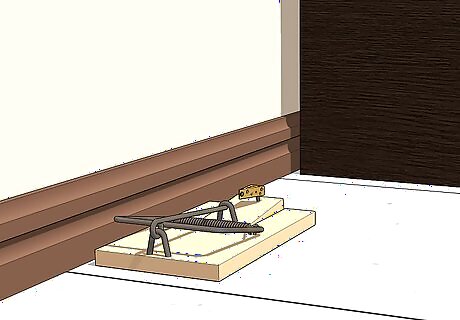
Set up traps near where the mice live. Although mice might live in your walls primarily, they almost always take a trip out into your home for food at night. Try to find the area where the mice exit the wall (usually, there will be a small hole near the floor). Then, set up your trap of choice near the hole so the mice have to encounter it when they leave. There are a couple of different mice trap styles to choose from, including: Two-door cage traps: this non-lethal trap lures the mice in with food (like peanut butter), then shuts a door behind them. Once you catch a mouse, you’ll need to take the trap and release the live mouse into the wild, far away from your home so they don’t run back inside. Snap traps: the classic mouse trap, it kills mice by snapping down on top of them. Bucket traps: these involve filling a bucket full of water and baiting the middle with food (usually by filling up a metal can with food, then hanging it on a metal rod to balance on the bucket ledge). When the mice go after it, they’ll drown in the bucket. Glue board/sticky traps: these traps work by trapping the mice in place. Usually, they kill mice by suffocation, since the mouse will try to bite their way out of the trap and then get glue in their mouth. However, glue traps are widely considered inhumane, and they are even illegal in parts of the US and the UK. Electric traps: when mice enter the trap, they’ll get shocked with a small burst of electricity. It wouldn’t be harmful to us, but it would kill the mice instantly. Poison traps and deterrent sprays are sometimes recommended in mice control, but they aren’t as effective as other traps, and they won’t get rid of an entire mouse infestation.
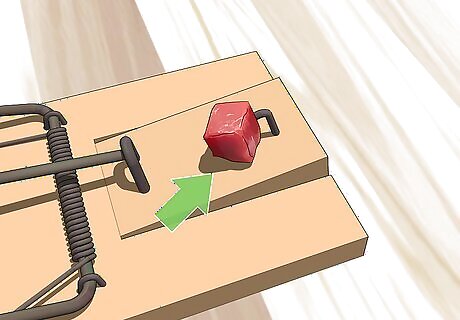
Bait the traps with food, like peanut butter or meat. Crunchy peanut butter, freshly-fried bacon, fruit, nutmeats, or gumdrops are popular choices that might tempt a mouse. When you set up your traps, be sure to load them up with tasty treats to get the mice to investigate. Try to eliminate other food sources, like pet food bowls or garbage bags. That way, the mice have no choice but to check out your traps. Although poison traps are sometimes an option, they aren’t ideal for mice in the walls. If a mouse crawls back into the wall to die, you probably won’t be able to retrieve the body very easily.

Angle the traps so the baited end is closest to the wall. If you know that the mice are living in your walls, you want to tempt them out with the food. Set the baited traps with the food facing the wall so that the mice can smell it. Add 1 trap per meter (yard) along the wall to cover the entire section. Or, if you can see the visible mouse hole, add 5 to 10 traps nearby. Mice and rats usually have 6 to 12 pups on average. If you see one mouse, you can probably bet there are at least a few more in your walls. Be sure to keep the traps out of the way of children and pets.

Check the traps daily. It’s important to dispose of dead mice right away so that your traps can keep catching new ones. In the mornings, check out your traps to see if you caught anything overnight. Dead mice might deter live mice from coming to check out the traps, which is why it’s important to get them out.
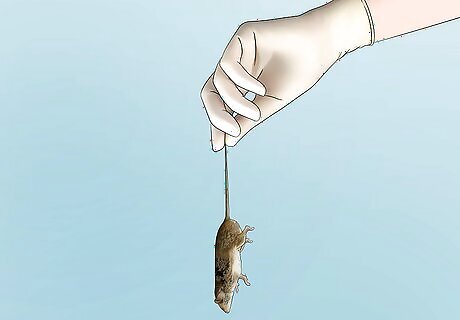
Put on gloves before disposing of dead mice in your traps. If you find a dead mouse, put on gloves to protect your hands before you touch it. Then, pick up the trap, trying not to touch the dead mouse directly. Throw the mouse into the trash, then set up the trap again with new food. Dead mice can carry dangerous diseases that are harmful to human health. Never touch a dead mouse directly, and throw away dead mice as soon as you can.
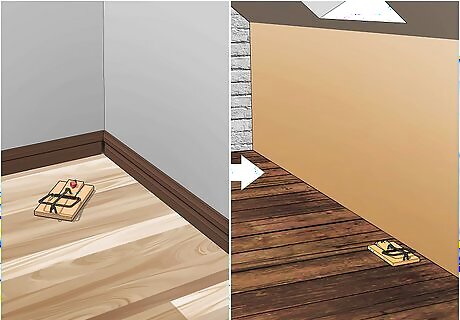
Move the traps if you haven’t caught any mice in a few days. If you still hear mice in your walls but your traps are empty, it’s time to move to a new location. Spread the traps out further down the walls or pick a different spot in your home where you think mice might be lurking. Small animals love dark, quiet spaces, so they might also be in your attic or your crawl space. If your traps haven’t worked after a week or so, call a professional pest control company.
Prevention
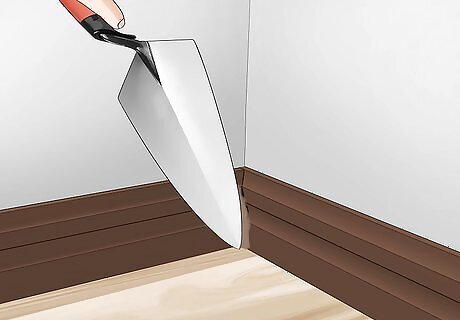
Seal any cracks or crevices in your home. Mice often enter in through openings in your attic and your crawl space. Walk outside the perimeter of your home and seal the openings with a permanent material, like silicone caulk. Once the mice leave, they won’t be able to get back in, which means they’ll leave your walls. Mice usually don’t stay in your home all day—they’ll leave to go find food elsewhere. If you can seal the entry points while they’re gone, you can get them out of your walls in no time.

Fill any gaps in your foundation. Mice can also enter your home if you have any cracks in the foundation. Check out the perimeter of your foundation to see if there are any loose bricks or holes in the concrete. If there are, you may need a professional to come take a look. Mice are very tiny, and can fit into super small openings. Even the tiniest crack could be letting mice into your home.

Stuff steel wool around pipes. If you’re caulking or plastering in pipes, grab some steel wool and fill in any gaps before moving on. Then, you can caulk and plaster knowing that the mice can’t chew through the wool. Even if you aren’t putting in new pipes, you can add steel wool to existing pipes if they have gaps before caulking. Check on your utility lines, too, like sewer, water, and gas. These lines usually create small openings that are easy for rodents to enter through.

Cover vents with mesh screening. Dryer vents, attic vents, and soffits are the perfect entry points for mice. Install mesh or wire screening to any vents in your home to prevent rodents from getting in. Be sure to check on the screens about once a year to make sure the mice haven’t chewed through them. Typically, mice leave your home up to 50 times per day.

Weather strip your doors and windows. Weather stripping is a type of foam tape that you can use to seal cracks around your doors and window fittings. Buy a roll of weather stripping from your local hardware store, then take a look around the entry points of your home. If you notice any cracks or gaps around your doors and windows, use strips of weather stripping to seal them up and prevent rodents. Weather stripping is sticky on one side, so all you have to do is peel off the plastic backing and stick it to your door or window frame.

Eliminate food and water sources. You can simply deter mice by making your home an uninviting place. Get rid of standing water, seal your food in airtight containers, and cover your trash cans with tight fitting lids. Eventually, the mice will move on to a new food and water source. If you’re dealing with mice, you may want to let your neighbors know about it. Mice will often travel to look for new food sources, so they could be checking out your neighbors’ houses too.
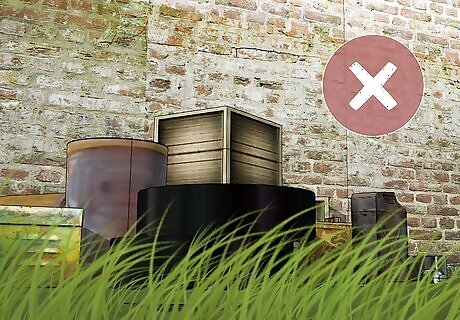
Remove nesting sites in and around your home. Mice love to get cozy in piles of clutter, yard debris, and tall grass. Try to keep stacks of wood or debris far away from your home, and make sure the inside of your house is relatively clean and clutter-free. The less inviting you can make your home and the surrounding area, the better. If you have any outdoor animals, like chickens, keep their food in an airtight container so the mice don’t try to eat it.




















Comments
0 comment